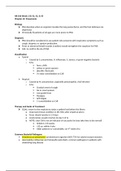Other
NR566 Week 2 Ch 42, 43, & 45 Complete Study Guide
- Course
- AIT Nursing (NR566)
- Institution
- Thompson River University (TRU )
NR 566 Week 2 Ch 42, 43, & 45 Chapter 42: Pneumonia Etiology PNA develops when an organism invades the lung parenchyma, and the host defenses are depressed. Chronically ill patients of all ages are more prone to PNA Diagnosis PNA should be considered in any patient who presen...
[Show more]



